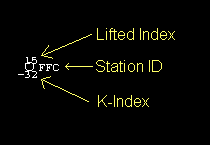Decoding Guide
Lifted Index Chart
Description:
This chart depicts the two common measures of air stability, the Lifted Index and the K-index. The lifted index is most often used as an indicator of severe weather, while the K-index is more closely related to general convection. The more negative the lifted index the more unstable the air mass is. The higher the K-index the greater the likelihood of convection.Issuance:
0000 and 1200 UTCData Sources:
Surface and upper air observations, computer modelsDiscussion:
When clouds and precipitation are forecast or are occurring, the stability index is used to determine the type of clouds and precipitation. That is, stratiform clouds and continuous precipitation occur with stable air, while convective clouds and showery precipitation occur with unstable air.Stability is also very important when considering the type, extent, and intensity of aviation weather hazards. For example, a quick estimate of areas of probable convective turbulence can be made by associating the area with unstable air. An area of extensive icing would be associated with stratiform clouds and steady precipitation which are characterized by stable air.
Depiction:
Individual observations are depicted in white. At each station, the lifted index value is plotted above a symbol and the k-index value is plotted below the symbol.Example:

A circle (positive LI) or shaded circle (negative LI) is usually used to indicate the station location, however, some symbols are used to indicate missing data.
Symbol interpretation:
| Lifted Index Positive (Stable) | |
| Lifted Index Negative (Unstable) | |
| All significant observations missing | |
| Some mandatory observations missing | |
| Some mandatory and significant observations missing |
